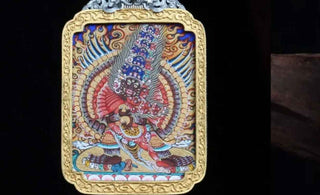
Thangka painting transcends the realm of mere artistic creation; it is a profound spiritual practice that fuses devotion, skill, and ancient wisdom. The artist, often a practitioner themselves, engages in a meticulous process that goes beyond the mere application of colors on canvas. The essence of Thangka painting lies in the fusion of art and spirituality, where each brushstroke becomes a sacred offering and every detail serves as a pathway to deeper understanding.
The very act of crafting a Thangka is an embodiment of devotion. The artist, fueled by a sincere commitment to their spiritual path, approaches the canvas with a reverence that transforms the painting process into a form of meditation. Before the first stroke, there is a moment of centering, a connection to the divine, and an acknowledgment of the sacred journey about to unfold. This initial act of devotion sets the tone for the entire artistic endeavor.
The spiritual aspect of Thangka painting is intricately tied to the intention behind the creation. Artists infuse their work with prayers, mantras, and positive aspirations, turning the canvas into a channel for spiritual energy. The Thangka becomes a visual representation of the artist's inner journey, a tangible expression of their devotion to the teachings and the divine beings they seek to portray.
In the depiction of deities, bodhisattvas, or sacred landscapes, the artist engages in a process that mirrors spiritual contemplation.
The process of depicting deities, bodhisattvas, or sacred landscapes in Thangka painting is a nuanced endeavor that transcends conventional artistic practice. It is a sacred journey undertaken by the artist, marked by profound spiritual contemplation at every stroke of the brush. Each moment spent with the canvas becomes a form of meditation, a deliberate act of mindfulness that extends beyond technical skill into the realm of divine connection.
The act of painting deities involves more than capturing a likeness; it is an exploration of the spiritual essence that defines these revered beings. The artist delves into the rich tapestry of Buddhist iconography, understanding that the colors chosen are not arbitrary but carriers of profound symbolic significance. Every hue is laden with meaning, representing aspects of the enlightened mind, spiritual virtues, and the transformative journey towards awakening.
As the artist engages in the meticulous rendering of details, it is not merely an exercise in craftsmanship but a homage to the divine intricacies of existence. Each line, curve, and contour is a deliberate choice, a reflection of the artist's deep understanding of the spiritual narratives they seek to convey. The process becomes a form of sacred geometry, where proportions are not just aesthetic considerations but reflections of the cosmic order and the interconnectedness of all things.
In the depiction of bodhisattvas, the artist engages in a profound exploration of compassion, wisdom, and the aspirational path towards Buddhahood. The facial expressions, hand gestures, and postures are not arbitrary; they are carefully chosen to communicate the qualities and virtues embodied by these enlightened beings. The artist becomes a storyteller, weaving narratives of altruism, compassion, and the boundless journey of selfless service.
Sacred landscapes, often featuring in Thangka paintings, become windows to transcendent realms. The artist, capturing mountains, rivers, and celestial realms, engages in a form of visual pilgrimage. Each stroke on the canvas becomes a step towards sacred terrains that symbolize the expansiveness of consciousness and the interconnectedness of the spiritual and material worlds.
The act of choosing colors is akin to selecting a palette of spiritual energies. The vibrancy of red may represent the fiery energy of wisdom, while the calming blues may evoke the serene waters of compassion. Gold leaf, often applied to highlight sacred features, transcends its materiality, symbolizing the divine radiance associated with enlightened beings. The artist, in this process, becomes a conduit for these symbolic energies, infusing the Thangka with a vibrancy that extends beyond the visual.
Moreover, the meticulous rendering of details reflects the artist's commitment to honoring the divinity inherent in the subject matter. Every ornate headdress, every lotus petal, and every celestial being is a testament to the artist's reverence for the sacred.Each stroke is a form of meditation, a deliberate act of mindfulness that goes beyond technical skill. The colors chosen are not arbitrary; they carry symbolic significance deeply rooted in Buddhist iconography. The meticulous rendering of details is not mere craftsmanship but a homage to the divine intricacies of existence.
The act of creating a Thangka becomes a spiritual ritual in itself. The artist, often working in silence or accompanied by chanting, transforms the studio space into a sacred sanctuary. The energy invested in the painting is not solely artistic; it is a form of spiritual devotion, an offering to the divine and a means of connecting with the spiritual realm.
Furthermore, Thangka painting involves a level of discipline that mirrors the discipline required in spiritual practice. The artist adheres to traditional techniques passed down through generations, following specific iconographic guidelines and proportions. This adherence is not a limitation but a conscious choice to align with a lineage of wisdom that extends back centuries.
The spiritual journey embedded in Thangka painting is also reflected in the choice of subject matter. Whether portraying Buddhas, bodhisattvas, or mandalas, each element carries layers of meaning that extend beyond the visual. The artist navigates the sacred narratives, infusing them with personal insights and interpretations, creating a unique dialogue between the ancient and the contemporary.
Conclusion
In conclusion, the crafting of Thangka art with devotion is a profound spiritual practice that transforms the act of painting into a form of meditation, offering, and contemplation. The artist becomes a conduit for ancient wisdom, infusing their work with the energy of devotion and aligning with the spiritual intentions embedded in the tradition. Thangka painting, therefore, stands as a testament to the transformative power of art when approached as a sacred journey, a practice that goes beyond the canvas and opens doors to the spiritual realms.























